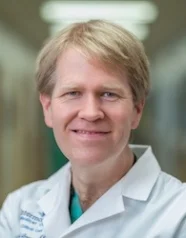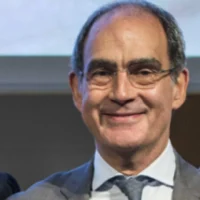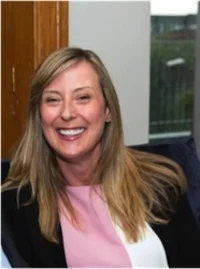Samuel Brown, MD, is Assistant Professor, Pulmonary and Critical Care Medicine and Medical Ethics and Humanities at the University of Utah School of Medicine in Salt Lake City, Utah, USA. He is also Director of the Center for Humanizing Critical Care and Assistant Director, Critical Care Echocardiography Service at Intermountain Medical Center.
1. What are your key areas of interest and research?
I have two primary interests, both focused on identifying and understanding patterns in complex data: cardiovascular function in sepsis and humanising intensive care. In the former, I started with studies of heart-rate variability and then added extensive work in critical care echocardiography. We are increasingly interested in understanding the interrelationships between the baroreflex system and cardiac function as measured by echocardiography, including interventional trials focused on improving baroreflex function. While it’s frustrating to see how many of our treatments ultimately fail during multicentre randomised controlled trials, I think there is still much to learn, especially about physiological integration, that may bear substantial, reproducible results in the future.
 In terms of humanising critical care, we’re using advanced analytic methods to phenotype patients and families in order to better tailor support for them during the difficult experience of a life-threatening illness. We’re also trying to help clinicians think about ways they can humanise the patient in the bed, especially through formal collaboration between clinicians and patients/families. I lay out the theory and details of this work in my new book, Through the Valley of Shadows: Living Wills, Intensive Care, and Making Medicine Human.
In terms of humanising critical care, we’re using advanced analytic methods to phenotype patients and families in order to better tailor support for them during the difficult experience of a life-threatening illness. We’re also trying to help clinicians think about ways they can humanise the patient in the bed, especially through formal collaboration between clinicians and patients/families. I lay out the theory and details of this work in my new book, Through the Valley of Shadows: Living Wills, Intensive Care, and Making Medicine Human.
2. What are the major challenges in your field?
In terms of cardiovascular physiology, the biggest problem is complexity, both at a given moment in time and over the course of an illness and its treatment. Different physicochemical relationships across multiple scales may be true at different moments, and superficially similar patients may in fact contain widely distinct processes. Randomised clinical trials in critical care are exceedingly blunt tools to dissect very complex questions. If we held bench scientists to the same standard (the experiment can be replicated in external environments in which the experimental subjects vary widely in unmeasured ways, cointerventions are almost wholly unregulated, and protocols commonly underspecify responses to contingencies), it’d be difficult to advance science very far. We needn’t imagine that each failure to replicate means the original science was in error. But on the other hand, we need to know whether a treatment based on fundamental science is likely to work in clinical practice, the variability in which is a major source of failures of replication. And we don’t want to continue with blind attachment to unsupported treatments. So we’re caught between these two important considerations: experimental rigour and external generalisability. Finding both balance and ways to improve rigour and generalisability are urgent topics for the current and future generations of researchers.
These problems won’t be magically solved through gene sequencing. We as a research community got distracted by the notion that genomics would tell us everything we needed to know about previously unmeasured variability, but we’re acknowledging more now how all the other -omics (as well as the practice environment and the patient’s personal history) and our ability to integrate these multiple data sources influence the rigour of the science and the meaning of our conclusions.
In terms of humanising intensive care, it’s a question of culture change, and intentional culture change is always very difficult. These changes may be especially hard in the ICU, where clinicians are busy and focused on getting our clinical and/or research work done. The cultural problems aren’t restricted to the ICU either. Changes in broader culture—a strong emphasis on individualism and legal solutions—may ironically make it harder to focus on the specific human needs of patients and families. So we have to work on restructuring both ICUs and making changes in our broader culture to help people be more capable of processing the risks of life-threatening illness and experiencing the sickbed and the deathbed healthfully.
3. What is your top management tip?
I believe that people do best as managers who find ways for the individuals under their care to flourish, to have a sense that their efforts contribute meaningfully to an important, lasting outcome. So my goal (admitting that I may not achieve it) is to figure out how to help others flourish in collaborations.
4. What would you single out as a career highlight?
While I spend most of my time on intellectual (generating or analysing data, writing manuscripts, revising protocols) or bureaucratic (budgets, institutional review boards, committees) pursuits, I think by far my favourite aspect of my career is when I have either prevented an untimely death or honoured a person well during a timely death. That’s why I personally think that being a medical academic is the most gratifying academic career. Because academic medicine is not just the life of the mind, it’s the life of human caring and making a concrete difference in people’s lives. It’s what drew me to the field in the first place.
5. If you had not chosen this career path you would have become a…?
All through college, I wanted to be a historian of religion or a professor of Greek classics. I’m fascinated by cultural differences, especially between the present and the past, and I admire the many different ways human beings have struggled with the meaning of life and the meaning of their own lives. I’m also intrigued by the ways language affects us. I studied theoretical syntax in college as a kind of compromise after I settled on medicine as my ultimate career path. In many respects my work in medical ethics and humanities has allowed me to keep some of these questions in play even as I work predominantly in biomedicine.
6. What are your personal interests outside of work?
Mostly cooking and opera. My wife taught me to cook a few years ago, and I love working from Yotam Ottolenghi’s books. I’m incredibly fond of the flavour palate of Near Eastern food and find Ottolenghi just brilliant in terms of his ability to see beauty and distinctive harmony in specific combinations of ingredients and styles. Flavours and experience are so much more alive for me now that I know how to cook. My wife also taught me to love opera, which I primarily experience in the local movie theatre as part of the Metropolitan Opera’s MetHD broadcasts. The quality of these broadcasts is staggering. Opera strikes me as a total art form, providing pleasure for many different senses on multiple axes. I find both cooking and opera allow me to sublimate some of the tensions associated with the stress of clinical work in the ICU.
7. Your favourite quote?
“The things which we inescapably find good often conflict, sometimes tragically. The attempt to hide this from ourselves is not only an intellectual failing, it is also a source of catastrophically destructive action, as we try to dragoon reality into our narrow conceptual net” - Charles Taylor.
Watch The Center for Humanizing Critical Care: Introduction
1. What are your key areas of interest and research?
I have two primary interests, both focused on identifying and understanding patterns in complex data: cardiovascular function in sepsis and humanising intensive care. In the former, I started with studies of heart-rate variability and then added extensive work in critical care echocardiography. We are increasingly interested in understanding the interrelationships between the baroreflex system and cardiac function as measured by echocardiography, including interventional trials focused on improving baroreflex function. While it’s frustrating to see how many of our treatments ultimately fail during multicentre randomised controlled trials, I think there is still much to learn, especially about physiological integration, that may bear substantial, reproducible results in the future.
 In terms of humanising critical care, we’re using advanced analytic methods to phenotype patients and families in order to better tailor support for them during the difficult experience of a life-threatening illness. We’re also trying to help clinicians think about ways they can humanise the patient in the bed, especially through formal collaboration between clinicians and patients/families. I lay out the theory and details of this work in my new book, Through the Valley of Shadows: Living Wills, Intensive Care, and Making Medicine Human.
In terms of humanising critical care, we’re using advanced analytic methods to phenotype patients and families in order to better tailor support for them during the difficult experience of a life-threatening illness. We’re also trying to help clinicians think about ways they can humanise the patient in the bed, especially through formal collaboration between clinicians and patients/families. I lay out the theory and details of this work in my new book, Through the Valley of Shadows: Living Wills, Intensive Care, and Making Medicine Human. 2. What are the major challenges in your field?
In terms of cardiovascular physiology, the biggest problem is complexity, both at a given moment in time and over the course of an illness and its treatment. Different physicochemical relationships across multiple scales may be true at different moments, and superficially similar patients may in fact contain widely distinct processes. Randomised clinical trials in critical care are exceedingly blunt tools to dissect very complex questions. If we held bench scientists to the same standard (the experiment can be replicated in external environments in which the experimental subjects vary widely in unmeasured ways, cointerventions are almost wholly unregulated, and protocols commonly underspecify responses to contingencies), it’d be difficult to advance science very far. We needn’t imagine that each failure to replicate means the original science was in error. But on the other hand, we need to know whether a treatment based on fundamental science is likely to work in clinical practice, the variability in which is a major source of failures of replication. And we don’t want to continue with blind attachment to unsupported treatments. So we’re caught between these two important considerations: experimental rigour and external generalisability. Finding both balance and ways to improve rigour and generalisability are urgent topics for the current and future generations of researchers.
These problems won’t be magically solved through gene sequencing. We as a research community got distracted by the notion that genomics would tell us everything we needed to know about previously unmeasured variability, but we’re acknowledging more now how all the other -omics (as well as the practice environment and the patient’s personal history) and our ability to integrate these multiple data sources influence the rigour of the science and the meaning of our conclusions.
In terms of humanising intensive care, it’s a question of culture change, and intentional culture change is always very difficult. These changes may be especially hard in the ICU, where clinicians are busy and focused on getting our clinical and/or research work done. The cultural problems aren’t restricted to the ICU either. Changes in broader culture—a strong emphasis on individualism and legal solutions—may ironically make it harder to focus on the specific human needs of patients and families. So we have to work on restructuring both ICUs and making changes in our broader culture to help people be more capable of processing the risks of life-threatening illness and experiencing the sickbed and the deathbed healthfully.
3. What is your top management tip?
I believe that people do best as managers who find ways for the individuals under their care to flourish, to have a sense that their efforts contribute meaningfully to an important, lasting outcome. So my goal (admitting that I may not achieve it) is to figure out how to help others flourish in collaborations.
4. What would you single out as a career highlight?
While I spend most of my time on intellectual (generating or analysing data, writing manuscripts, revising protocols) or bureaucratic (budgets, institutional review boards, committees) pursuits, I think by far my favourite aspect of my career is when I have either prevented an untimely death or honoured a person well during a timely death. That’s why I personally think that being a medical academic is the most gratifying academic career. Because academic medicine is not just the life of the mind, it’s the life of human caring and making a concrete difference in people’s lives. It’s what drew me to the field in the first place.
5. If you had not chosen this career path you would have become a…?
All through college, I wanted to be a historian of religion or a professor of Greek classics. I’m fascinated by cultural differences, especially between the present and the past, and I admire the many different ways human beings have struggled with the meaning of life and the meaning of their own lives. I’m also intrigued by the ways language affects us. I studied theoretical syntax in college as a kind of compromise after I settled on medicine as my ultimate career path. In many respects my work in medical ethics and humanities has allowed me to keep some of these questions in play even as I work predominantly in biomedicine.
6. What are your personal interests outside of work?
Mostly cooking and opera. My wife taught me to cook a few years ago, and I love working from Yotam Ottolenghi’s books. I’m incredibly fond of the flavour palate of Near Eastern food and find Ottolenghi just brilliant in terms of his ability to see beauty and distinctive harmony in specific combinations of ingredients and styles. Flavours and experience are so much more alive for me now that I know how to cook. My wife also taught me to love opera, which I primarily experience in the local movie theatre as part of the Metropolitan Opera’s MetHD broadcasts. The quality of these broadcasts is staggering. Opera strikes me as a total art form, providing pleasure for many different senses on multiple axes. I find both cooking and opera allow me to sublimate some of the tensions associated with the stress of clinical work in the ICU.
7. Your favourite quote?
“The things which we inescapably find good often conflict, sometimes tragically. The attempt to hide this from ourselves is not only an intellectual failing, it is also a source of catastrophically destructive action, as we try to dragoon reality into our narrow conceptual net” - Charles Taylor.
Watch The Center for Humanizing Critical Care: Introduction









